We may receive a commission when you use our affiliate links. However, this does not impact our recommendations.
Because my wife and I recently moved, everything in our old place had to be packed, including the contents of most drawers, etc. While I was at it, I took a closer look at a Victorian-era serpentine chest we inherited years ago. Although I’m not a fan of this furniture style, I’ve always found this to be a beautiful chest of drawers. It was obviously made by highly skilled hands and I assume it was, even in it’s day, a “high-end piece.”
As I checked it out, I took some photos that I thought others might find interesting. This chest has many similarities to the chest we recently featured on the February 2012 cover of Popular Woodworking Magazine, another beautiful piece built by contributing editor Glen Huey.
The one thing I didn’t find was a maker’s mark, I’m sorry to say. There are some chalk markings you’ll see in the photos. If anyone has thoughts on what these might mean, please share. Some I figure are dimensions, or the order of pieces to be assembled. You can take a closer look by clicking on the image to enlarge it. You can even check out the lint, cobwebs and more than a century of dust.
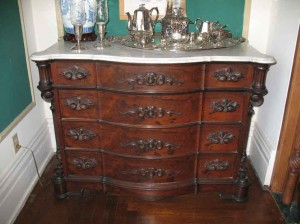
The serpentine chest features a marble top, is highly carved and has a spectacular grain-painted faux rosewood finish that's original to the piece.
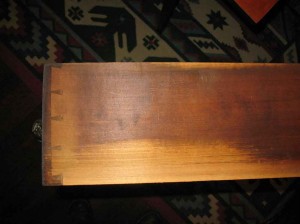
Look at those delicate dovetails. The color change is from the drawer sides rubbing on the drawer runners.
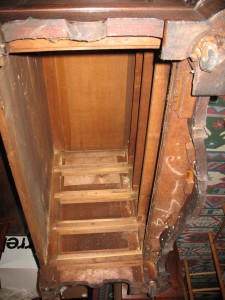
A view of the full case interior looking through the case bottom. More chalk markings on the bottom of the serpentine base.
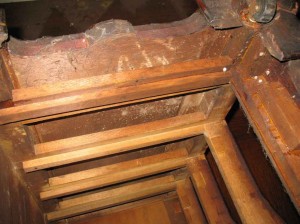
Again, from the bottom, the case side with drawer runners and drawer blades. A bit more chalk on the case side. I'm certain the casters are not original. Oh, yeah, lots of cob webs and spider egg sacs.
Hope you enjoyed the tour! And let me know your thoughts on those markings.
Here are some supplies and tools we find essential in our everyday work around the shop. We may receive a commission from sales referred by our links; however, we have carefully selected these products for their usefulness and quality.










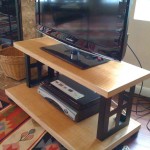
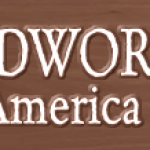
I’ll place my bet on shipping or inventory marks. Mills and lumber yards of yore, would mark logs and milled lumber with chalk to identify grade, etc. There is mention of this in Hasluck’s wonderful book, Carpentry & Joinery.
I think the chalk on the drawer is a date 3-1916
Steve,
How is the marble top attached? I am building a pair of end tables that my wife would like to have granite or something similar on the top.
Thanks
Steve, I love this piece and it is somewhat consistent with my taste. Thank you very much for showing it. Fred
Speaking of moving, Popular Woodworking Magazine is holding their annual open house at their new location, on March 30 and 31. Was this mentioned on the PW web site?
The other chalk marks might be 5′ 4 & ?/4″??
Just a guess.
Nice furniture piece Steve, not my style either, but you can easily appreciate the work.
Check the pieces that are marked, look at how they are finished, worked, etc., and see if it differs from the rest of the piece. Repaired later buy a craftsman who marked his work pieces maybe?
Chalk is always good, and unlike a pencil if you know how to use it, it`s self sharpening.
Ahhh…. furniture I can relate to! Have to admit, I’m more a restorer than a maker or new furniture kind of guy. The chalk marks are very typical. Chalk was cheap, pencils were expensive.
In this case, the upper drawer looks as if it was meant for toilet items as well as unmentionables.
As you noted, the base is a bit attenuated. It should be taller, having 4 or 6 inches of leg instead of the wheels. My off the cuff guess is Germanic in origin but I’m not an expert in this particular style.
A lot of times moving companies put chalk marks like that on furniture. They used chalk because it was an easy way to place a temporary marking that did not harm the furniture.
The chalk marks on the back of the drawer look to me like a dimension of 3′-1 9/16